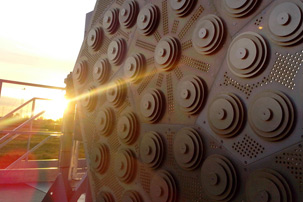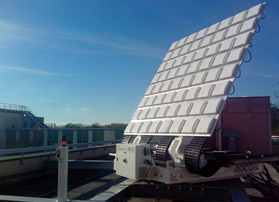During the launch of ExoMars ESA mission on 14 March, ABISS radar breadboard developed by ONERA has been operated to confirm the progress of the martian mission with the successful passage of the launcher on its transfer orbit.
The European radar ABISS for space surveillance is a bistatic radar 'breadboard'*, developed for the European Space Agency (ESA), now experimented by ONERA. The transmitting system is installed in the old NATO base of Crucey in Normandy and the receiving system is in ONERA Palaiseau centre. ABISS radar has been designed to detect a 1m diameter reference target at a reference altitude of 350 km. Spatial objects (satellites or debris) can be thus detected at different altitudes in function of their size.
|
|
|
|
ESA asked to ONERA to detect ExoMars spacecraft and to confirm its presence on its transfer orbit during its passage over Europe. Therefore ABISS system has been settled to optimize the detection of the spacecraft still attached to the last stage of the launcher when it passed over Europe at 800 km altitude.
Few hours after the confirmation of the launch by ESA, the system was ready to operate. As expected, the passage of the spacecraft through the surveillance area has been detected in real time with the radar. A specific signature of the object changing its orbit has been clearly observed at foreseen moment. ESA has been informed of this detection in near real-time to confirm the passage. Thus ESA got one complementary reassuring information about the good progress of the mission during this blind phase … waiting to establish later contact with the spacecraft (the launch was operated and under controlled by russian space agency).
A posteriori retiming allowed refining the detections after correlation with a more precise trajectory given by ESA in the days after.

Radar plots corresponding to ExoMars passage detection (circled in red)
Reference trajectory (black) in azimuth, elevation and Doppler (i.e. speed)
Blue dots correspond to residual false alarms.
With this full scale demonstration in real-time ABISS capacities have been successfully confirmed. ESA expressed its great satisfaction to ONERA personals involved in the project for the success of this experiment which shows the excellent performances of ABISS radar breadboard.
* breadboard : a radar that is easily reconfigurable depending on test results, helping engineers to optimise its performance over time
"



 ABISS transmitting antennas array- Crucey (Normandy)
ABISS transmitting antennas array- Crucey (Normandy) ABISS receiving antenna - Palaiseau (south of Paris)
ABISS receiving antenna - Palaiseau (south of Paris)
